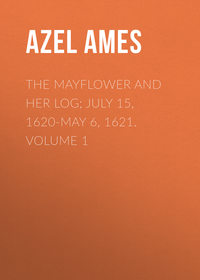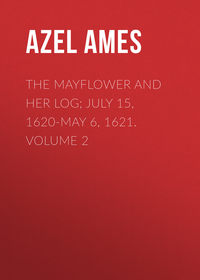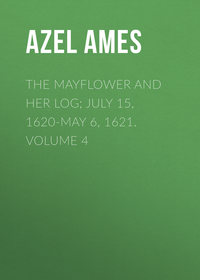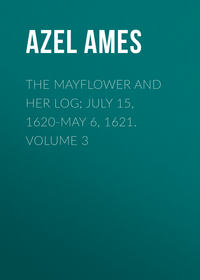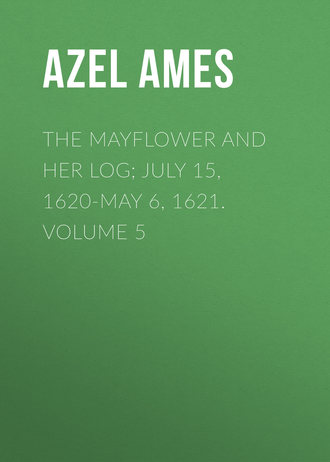 полная версия
полная версияThe Mayflower and Her Log; July 15, 1620-May 6, 1621. Volume 5

Azel Ames
The Mayflower and Her Log; July 15, 1620-May 6, 1621 – Volume 5
CHAPTER VII
QUARTERS, COOKING, PROVISIONS
Probably no more vexatious problem presented itself for the time being to the "governors" of the two vessels and their "assistants," upon their selection, than the assignment of quarters to the passengers allotted to their respective ships. That these allotments were in a large measure determined by the requirements of the women and children may be considered certain. The difficulties attendant on due recognition of social and official station (far more imperative in that day than this) were in no small degree lessened by the voluntary assignment of themselves, already mentioned, of some of the Leyden chief people to the smaller ship; but in the interests of the general welfare and of harmony, certain of the leaders, both of the Leyden and London contingents, were of necessity provided for in the larger vessel. The allotments to the respective ships made at Southampton, the designation of quarters in the ships themselves, and the final readjustments upon the MAY-FLOWER at Plymouth (England), when the remaining passengers of both ships had been united, were all necessarily determined chiefly with regard to the needs of the women, girls, and babes. Careful analysis of the list shows that there were, requiring this especial consideration, nineteen women, ten young girls, and one infant. Of the other children, none were so young that they might not readily bunk with or near their fathers in any part of the ship in which the latter might be located.
We know enough of the absolute unselfishness and devotion of all the Leyden leaders, whatever their birth or station,—so grandly proven in those terrible days of general sickness and death at New Plymouth,—to be certain that with them, under all circumstances, it was noblesse oblige, and that no self-seeking would actuate them here. It should be remembered that the MAY-FLOWER was primarily a passenger transport, her passengers being her principal freight and occupying the most of the ship, the heavier cargo being chiefly confined to the "hold." As in that day the passenger traffic was, of course, wholly by sailing vessels, they were built with cabin accommodations for it, as to numbers, etc., proportionately much beyond those of the sailing craft of to-day. The testimony of Captain John Smith, "the navigator," as to the passengers of the MAY-FLOWER "lying wet in their cabins," and that of Bradford as to Billington's "cabin between decks," already quoted, is conclusive as to the fact that she had small cabins (the "staterooms" of to-day), intended chiefly, no doubt, for women and children. The advice of Edward Winslow to his friend George Morton, when the latter was about to come to New England in the ANNE, "build your cabins as open as possible," is suggestive of close cabins and their discomforts endured upon the MAY-FLOWER. It also suggests that the chartering-party was expected in those days to control, if not to do, the "fitting up" of the ship for her voyage. In view of the usual "breadth of beam" of ships of her class and tonnage, aft, and the fore and aft length of the poop, it is not unreasonable to suppose that there were not less than four small cabins on either side of the common (open) cabin or saloon (often depicted as the signing-place of the Compact), under the high poop deck. Constructed on the general plan of such rooms or cabins to-day (with four single berths, in tiers of two on either hand), there would be—if the women and girls were conveniently distributed among them—space for all except the Billingtons, who we know had a cabin (as had also doubtless several of the principal men) built between decks. This would also leave an after cabin for the Master, who not infrequently made his quarters, and those of his chief officer, in the "round house," when one existed, especially in a crowded ship.
Cabins and bunks "between decks" would provide for all of the males of the company, while the seamen, both of the crew and (some of) those in the employ of the Pilgrims—like Trevore and Ely—were no doubt housed in the fore castle. Alderton and English seem to have been counted "of the company." The few data we have permit us to confidently assume that some such disposition of the passengers was (necessarily) made, and that but for the leaky decks, the inseparable discomforts of the sea, and those of over crowding, the wives of the Pilgrims (three of whom gave birth to children aboard the ship), and their daughters, were fairly "berthed."
Bradford is authority for the statement that with the "governor" of the ship's company were chosen "two or three assistants . . . to order [regulate] the people by the way [on the passage] and see to the disposition of the provisions," etc. The last-named duty must have been a most difficult and wearisome one. From what has been shown of the poverty of the ship's cooking facilities (especially for so large a company), one must infer that it would be hopeless to expect to cook food in any quantity, except when all conditions favored, and then but slowly and with much difficulty. From the fact that so many would require food at practically the same hours of the day, it is clear that there must have been distribution of food (principally uncooked) to groups or families, who, with the aid of servants (when available), must each have prepared their own meals, cooking as occasion and opportu nity indicated; much after the manner of the steerage passengers in later days, but before those of the great ocean liners. There appears to have been but one cook for the officers and crew of the ship, and his hands were doubtless full with their demands. It is certain that his service to the passengers must have been very slight. That "the cook" is named as one of the ship's crew who died in Plymouth harbor (New England) is all the knowledge we have concerning him.
The use of and dependence upon tea and coffee, now so universal, and at sea so seemingly indispensable, was then unknown, beer supplying their places, and this happily did not have to be prepared with fire. "Strong waters"—Holland gin and to some extent "aqua vitae" (brandy)—were relied upon for the (supposed) maintenance of warmth. Our Pilgrim Fathers were by no means "total abstainers," and sadly bewailed being deprived of their beer when the supply failed. They also made general and habitual (moderate) use of wine and spirits, though they sharply interdicted and promptly punished their abuse.
In the absence of cooking facilities, it became necessary in that day to rely chiefly upon such articles of food as did not require to be prepared by heat, such as biscuit (hard bread), butter, cheese ("Holland cheese" was a chief staple with the Pilgrims), "haberdyne" (or dried salt codfish), smoked herring, smoked ("cured ") ham and bacon, "dried neat's tongues," preserved and "potted" meats (a very limited list in that day), fruits, etc. Mush, oatmeal, pease-puddings, pickled eggs, sausage meats, salt beef and pork, bacon, "spiced beef," such few vegetables as they had (chiefly cabbages, turnips, and onions,—there were no potatoes in that day), etc., could be cooked in quantity, when the weather permitted, and would then be eaten cold.
Except as dried or preserved fruits, vegetables (notably onions), limes, lemon juice, and the free use of vinegar feebly counteracted, their food was distinctively stimulant of scorbutic and tuberculosis disease, which constant exposure to cold and wet and the overcrowded state of the ship could but increase and aggravate. Bradford narrates of one of the crew of the MAY-FLOWER when in Plymouth harbor, as suggestive of the wretched conditions prevalent in the ship, that one of his shipmates, under an agreement to care for him, "got him a little spice and made him a mess of beef, once or twice," and then deserted him.
Josselyn, in his "Two Voyages to New England," gives as the result of the experience and observations had in his voyages, but a few years later, much that is interesting and of exceptional value as to the food and equipment of passengers to, and colonists in, this part of America. It has especial interest, perhaps, for the author and his readers, in the fact that Josselyn's statements were not known until after the data given in these pages had been independently worked out from various sources, and came therefore as a gratifying confirmation of the conclusions already reached.
Josselyn says as to food, as follows:—"The common proportion of victuals for the sea to a mess (being 4 men) is as followeth:—
"2 pieces of Beef of 3 lb. 1/4 apiece. Pork seems to have been inadvertently omitted.
"Four pounds of Bread [ship-bread].
"One pint & 1/2 of Pease.
"Four Gallons of Bear [Beer], with mustard and vinegar for 3 flesh days in the week."
"For four fish days to each mess per day:—
"Two pieces of Codd or Haberdine, making 3 pieces of a fish, i.e. a dried salt cod being divided into three pieces, 2 of those pieces were to be a day's ration for 4 men.
"Four pounds of Bread.
"Three-quarters of a pound of cheese.
"Bear as before."
"Oatmeal per day for 50 men 1 Gallon [dry], and so proportionable for more or fewer."
"Thus you see the ship's provision is Beefe and Porke, Fish, Butter,
Cheese, Pease, Pottage, Water-Gruel, Bisket, and six shilling Bear."
"For private fresh provision you may carry with you (in case you or any of yours should be sick at sea):—
"Conserves of Roses, Clove-Gilliflowers, Wormwood, Green-Ginger, BurntWine, English Spirits, Prunes to stew, Raisons of the Sun, Currence [currants], Sugar, Nutmeg, Mace, Cinna mon, Pepper and Ginger, White Bisket, Butter, or 'Captains biscuit,' made with wheat flour or Spanish Rusk, Eggs, Rice, Juice of Lemons, well put up to cure or prevent the Scurvy, Small Skillets, Pipkins, Porringers and small Frying Pans."
Josselyn further gives us an estimate for:—
"Victuals for a whole year to be carried out of England for one man and so for more after this rate." He annexed also their current prices:—
"Eight bushels of Meal [Rye meal probably intended]
Two bushels of Pease at 3/s
Two bushels of Oatmeal at 4s/6d
One Gallon of Aqua Vitae
One Gallon of Oyl
Two Gallons of Vinegar
[No estimate of Beef or Pork, or of vegetables, is included.]
A Hogshead of English Bear
A Hogshead of Irish Bear
A Hogshead of Vinegar
A bushel of Mustard seed
A Kental [Quintal] of fish, Cod or Haberdine, 112 lb."
Edward Window, in his letter to George Morton before mentioned, advising him as to his voyage, says: "Bring juice of lemons and take it fasting. It is of good use."
It is indeed remarkable that, totally unused to any such conditions, wet, cold, poorly fed, overcrowded, storm-tossed, bruised and beaten, anxious, and with no homes to welcome them, exposed to new hardships and dangers on landing, worn and exhausted, any of the MAY-FLOWER'S company survived. It certainly cannot be accounted strange that infectious diseases, once started among them, should have run through their ranks like fire, taking both old and young. Nor is it strange that—though more inured to hardship and the conditions of sea life—with the extreme and unusual exposure of boat service on the New England coast in mid winter, often wading in the icy water and living aboard ship in a highly infected atmosphere, the seamen should have succumbed to disease in almost equal ratio with the colonists. The author is prepared, after careful consideration, to accept and professionally indorse, with few exceptions, the conclusions as to the probable character of the decimating diseases of the passengers and crew of the MAY-FLOWER, so ably and interestingly presented by Dr. Edward E. Cornwall in the "New England Magazine" for February, 1897—From the fact that Edward Thompson, Jasper More, and Master James Chilton died within a month of the arrival at Cape Cod (and while the ship lay in that harbor), and following the axiom of vital statistics that "for each death two are constantly sick," there must have been some little (though not to say general) sickness on the MAY-FLOWER when she arrived at Cape Cod. It would, in view of the hardship of the voyage, have been very remarkable if this had not been the case. It would have been still more remarkable if the ill-conditioned, thin- blooded, town-bred "servants" and apprentices had not suffered first and most. It is significant that eight out of nine of the male "servants" should have died in the first four months. It was impossible that scurvy should not have been prevalent with both passengers and crew.
CHAPTER VIII
THE MAY-FLOWER'S LADING
Beside her human freight of one hundred and thirty or more passengers and crew, the lading of the MAY-FLOWER when she sailed from Plymouth (England), September 6/16, 1620, was considerable and various. If clearing at a custom-house of to-day her manifest would excite no little interest and surprise. Taking no account of the ship's stores and supplies (necessarily large, like her crew, when bound upon such a voyage, when every possible need till her return to her home port must be provided for before sailing), the colonists' goods and chattels were many, their provisions bulky, their ordnance, arms, and stores (in the hold) heavy, and their trading-stock fairly ample. Much of the cargo originally stowed in the SPEEDWELL, a part, as we know, of her company, and a few of her crew were transferred to the MAY-FLOWER at Plymouth, and there can be no doubt that the ship was both crowded and overladen.
It is altogether probable that the crowded condition of her spar and main decks caused the supply of live-stock taken—whether for consumption upon the voyage or for the planters' needs on shore—to be very limited as to both number and variety. It has been matter of surprise to many that no cattle (not even milch-cows) were taken, but if—as is not unlikely—it was at first proposed to take a cow or two (when both ships were to go and larger space was available), this intent was undoubtedly abandoned at Plymouth, England, when it became evident that there would be dearth of room even for passengers, none whatever for cattle or their fodder (a large and prohibitive quantity of the latter being required for so long a voyage), and that the lateness of the season and its probable hardships would endanger the lives of the animals if taken. So far as appears the only domestic live-stock aboard the MAY-FLOWER consisted of goats, swine, poultry, and dogs. It is quite possible that some few sheep, rabbits, and poultry for immediate consumption (these requiring but little forage) may have been shipped, this being customary then as now. It is also probable that some household pets—cats and caged singing-birds, the latter always numerous in both England and Holland—were carried on board by their owners, though no direct evidence of the fact is found. There is ample proof that goats, swine, poultry, and dogs were landed with the colonists at New Plymouth, and it is equally certain that they had at first neither cattle, horses, nor sheep. Of course the she-goats were their sole reliance for milk for some time, whether afloat or ashore, and goat's flesh and pork their only possibilities in the way of fresh meat for many months, save poultry (and game after landing), though we may be sure, in view of the breeding value of their goats, poultry, and swine, few were consumed for food. The "fresh meat" mentioned as placed before Massasoit' on his first visit was probably venison, though possibly kid's meat, pork, or poultry. Of swine and poultry they must have had a pretty fair supply, judging from their rapid increase, though their goats must have been few. They were wholly without beasts of draft or burden (though it seems strange that a few Spanish donkeys or English "jacks" had not been taken along, as being easily kept, hardy, and strong, and quite equal to light ploughing, hauling, carrying, etc.), and their lack was sorely felt. The space they and their forage demanded it was doubtless considered impracticable to spare. The only dogs that appear in evidence are a large mastiff bitch (the only dog of that breed probably seen on these shores since Pring's "bigge dogges" so frightened the Indians' in this region seventeen years before)
[Captain Martin Pring had at Plymouth, in 1603, two great "mastive dogges" named "Fool" and "Gallant," the former being trained to carry a half-pike in his mouth. "The Indians were more afraid of these dogs than of twenty men." American Magazine of History; Goodwin, Pilgrim Republic, p. 3.]
and a small spaniel, both the property of passengers, though there may have been others not mentioned. Speaking of the venison found in a tree by one of the exploring parties, Winslow says: "We thought it fitter for the dogs than for us," perhaps suggesting by his word "the" their own dogs aboard ship and provision for them. There is an intimation as to the ownership of these two dogs in the facts that on certainly two occasions John Goodman was accompanied by the little spaniel (once when alone), from which it may perhaps be inferred that he was the dog's master; while the big mastiffs presence when only Peter Browne and Goodman were together suggests that Browne was her owner. The goats, swine, rabbits, and poultry were doubtless penned on the spar-deck forward, while possibly some poultry, and any sheep brought for food, may have been temporarily housed—as was a practice with early voyagers—in the (unused) ship's boats, though these appear to have been so few in number and so much in demand that it is doubtful if they were here available as pens. The heavy cargo and most of the lighter was of course stowed in the hold, as the main deck (or "'tween decks") was mostly occupied as quarters for the male passengers, old and young, though the colonists' shallop, a sloop-rigged boat some thirty feet in length, had been "cut down" and stowed "between the decks" for the voyage. A glimpse of the weary life at sea on that long and dreary passage is given in Bradford's remark that "she was much opened with the people's lying in her during the voyage:' This shallop with her equipment, a possible spare skiff or two, the chests, "boxes," and other personal belongings of the passengers, some few cases of goods, some furniture, etc., constituted the only freight for which there could have been room "between decks," most of the space (aft) being occupied by cabins and bunks.
The provisions in use, both by passengers and crew, were probably kept in the lazarette or "runs," in the stern of the ship, which would be unusually capacious in vessels of this model; some—the bulkiest—in the hold under the forward hatch, as the custom was, and to some extent still is. The food supply of the Pilgrims, constituting part of the MAY- FLOWER'S Cargo, included, as appears from authentic sources:—
Breadstuff's, including,—
Biscuits or ship-bread (in barrels).
Oatmeal (in barrels or hogsheads).
Rye meal (in hogsheads).
Butter (in firkins).
Cheese, "Hollands" and English (in boxes).
Eggs, pickled (in tubs).
Fish, "haberdyne" [or salt dried cod] (in boxes).
Smoked herring (in boxes).
Meats, including,—
Beef, salt, or "corned" (in barrels).
Dry-salted (in barrels).
Smoked (in sacks).
Dried neats'-tongues (in boxes).
Pork, bacon, smoked (in sacks or boxes).
Salt [" corned "] (in barrels).
Hams and shoulders, smoked (in canvas sacks or hogsheads).
Salt (in bags and barrels).
Vegetables, including,—
Beans (in bags and barrels).
Cabbages (in sacks and barrels).
Onions (in sacks).
Turnips (in sacks).
Parsnips (in sacks).
Pease (in barrels), and
Vinegar (in hogsheads), while,—
Beer (in casks), brandy, "aqua vitae" (in pipes), and gin ["Hollands,"
"strong waters," or "schnapps"] (in pipes) were no small or unimportant part, from any point of view, of the provision supply.
Winslow, in his letter to George Morton advising him as to his preparations for the voyage over, says: "Be careful to have a very good bread-room to keep your biscuit in." This was to keep them from dampness. Winthrop gives us the memorandum of his order for the ship- bread for his voyage in 1630. He says: "Agreed with Keene of Southwark, baker, for 20,000 of Biscuit, 15,000 of brown, and 5,000 of white." Captain Beecher minutes: "10 M. of bread for the ship ARBELLA." Beecher's memorandum of "oatmeal" is "30 bushels." Winslow mentions "oatmeal," and Winthrop notes among the provisions bought by Captain William Pierce, "4 hhds. of oatmeal." Rye meal was usually meant by the term "meal," and Window in his letter to George Morton advises him: "Let your meal be so hard-trod in your casks that you shall need an adz or hatchet to work it out with;" and also to "be careful to come by [be able to get at] some of your meal to spend [use] by the way." Notwithstanding that Bradford' speaks of their "selling away" some "60 firkins of butter," to clear port charges at Southampton, and the leaders, in their letter to the Adventurers from that port (August 3), speak of themselves, when leaving Southampton in August, 1620, as "scarce having any butter," there seems to have been some left to give as a present to Quadrequina, Massasoit's brother, the last of March following, which would indicate its good "keeping" qualities. Wood, in his "New England's Prospect" (ch. 2), says: "Their butter and cheese were corrupted." Bradford mentions that their lunch on the exploration expedition of November 15, on Cape Cod, included "Hollands cheese," which receives also other mention. There is a single mention, in the literature of the day, of eggs preserved in salt, for use on shipboard. "Haberdyne" (or dried salt cod) seems to have been a favorite and staple article of diet aboard ship. Captain Beecher minutes "600 haberdyne for the ship ARBELLA." Wood says: "Their fish was rotten." Smoked "red-herring" were familiar food to all the MAY-FLOWER company. No house or ship of England or Holland in that day but made great dependence upon them. Bacon was, of course, a main staple at sea. In its half-cooked state as it came from the smoke-house it was much relished with their biscuit by seamen and others wishing strong food, and when fried it became a desirable article of food to all except the sick. Mention is made of it by several of the early Pilgrim writers. Carlyle, as quoted, speaks of it as a diet-staple on the MAY-FLOWER. Salt ("corned") beef has always been a main article of food with seamen everywhere. Wood' states that the "beef" of the Pilgrims was "tainted." In some way it was made the basis of a reputedly palatable preparation called "spiced beef," mentioned as prepared by one of the sailors for a shipmate dying on the MAY-FLOWER in Plymouth harbor. It must have been a very different article from that we now find so acceptable under that name in England. Winthrop' gives the price of his beef at "19 shillings per cwt." Winslow advises his friend Morton, in the letter so often quoted, not to have his beef "dry-salted," saying, "none can do it better than the sailors," which is a suggestion not readily understood. "Smoked" beef was practically the same as that known as "jerked," "smoked," or "dried" beef in America. A "dried neat's- tongue" is named as a contribution of the Pilgrims to the dinner for Captain Jones and his men on February 21, 1621, when they had helped to draw up and mount the cannon upon the platform on the hill at Plymouth. Winthrop paid "14d. a piece" for his "neats' tongues." The pork of the Pilgrims is also said by Wood' to have been "tainted." Winthrop states that his pork cost "20 pence the stone" (14 lbs.).
Hams seem to have been then, as now, a highly-prized article of diet.
Goodwin mentions that the salt used by the Pilgrims was (evaporated) "sea-salt" and very "impure." Winthrop mentions among his supplies,
"White, Spanish, and Bay salt."
The beans of the Pilgrims were probably of the variety then known as "Spanish beans." The cabbages were apparently boiled with meat, as nowadays, and also used considerably for "sour-krout" and for pickling, with which the Leyden people had doubtless become familiar during their residence among the Dutch. As anti-scorbutics they were of much value. The same was true of onions, whether pickled, salted, raw, or boiled. Turnips and parsnips find frequent mention in the early literature of the first settlers, and were among their stock vegetables. Pease were evidently staple articles of food with the Plymouth people, and are frequently named. They probably were chiefly used for porridge and puddings, and were used in large quantities, both afloat and ashore.




